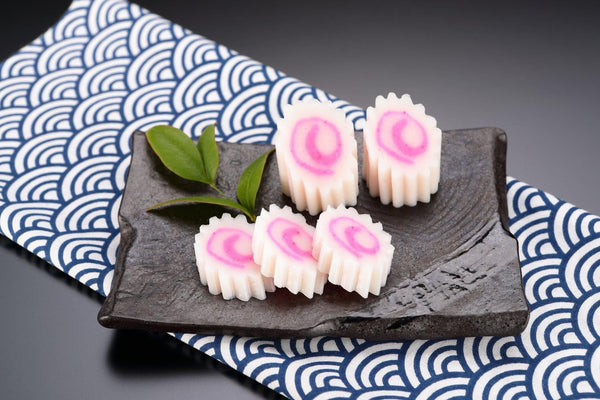
Jump to:
When enjoying a steaming bowl of Shoyu Ramen, you may have noticed a white cloud-like object with a pink swirl floating amongst the predominantly brown ingredients of the dish. If so, you will have been looking at Narutomaki, which is a kind of Japanese fish cake.
In this blog post, we shall be looking at what Narutomaki is and how it is made, its history, the main areas of production, and whether you can make it yourself. We shall also look at some common dishes that may include Narutomaki, discuss whether it is the same thing as Kamaboko, and round off by discussing where to buy it and how to store it.
What Is Narutomaki?
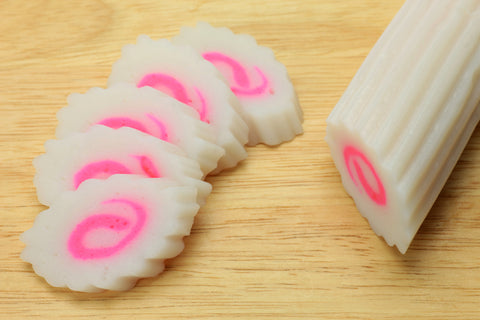
So, what is Narutomaki? Simply put, it is a kind of white Japanese fish cake with a pink swirl on it. The white part of Narutomaki is made of Surimi. This is minced fish that has been rinsed and blended with sugar. As the fish is rinsed well, it does not have an overpoweringly fishy taste. Surimi is big business in Japan, and it is claimed that around 2-3% of the world’s fishery is used to make Surimi.
The fish used is non-oily white fish fillets, such as Alaska pollock or southern blue whiting.
The sugar is added to increase the stability of the product and points to the fact that it hails from a world before the convenience of refrigeration when adding sugar was required to give some longevity to the product. The Surimi is then molded into a log form and steamed. Red or pink food coloring is added to a layer of the Surimi to give the pink swirl effect.
When it comes to the origin of the name, a common misconception is that it comes from the globally popular Japanese anime, called “Naruto.” It does, in fact, have nothing at all to do with this, but rather it is named after the Naruto strait in Japan. Located between Awaji Island and Shikoku, this is considered to be the fastest-moving stretch of water in Japan and is famous for its whirlpools, hence the pink design on Narutomaki.
What Is Fish Cake In Japanese?
Fish cake in Japanese is called "kamaboko" (かまぼこ). Kamaboko is a type of processed seafood product made from minced fish (usually white fish) that is formed into a cake and steamed or boiled. It is often served sliced and can be found in various dishes, such as soups, noodle dishes, and as a side dish. There are different types of kamaboko, and narutomaki is one of them.
History of Narutomaki Fish Cake
When looking at the origins of Narutomaki, it is useful to look at the history of fish paste usage. Records show that fish paste has been consumed in Japan at least as far back as the Heian period (794-1192). At this time, the fish paste was skewered on a bamboo stick and roasted over a fire. This type of fish cake could be seen as the origin of the modern-day favorite, Chikuwa.
The emergence of Narutomaki, however, came later than this, in the 16th Century. According to a book called “Konnyaku Hyaku chin” from the Edo period, Narutomaki was eaten wrapped in kelp or tofu skin.
Although it is now best known as a ramen topping, Narutomaki was originally a topping for Soba and Udon noodles. As Ramen grew in popularity, however, some Soba chefs became ramen chefs and took Narutomaki with them as a topping when they switched over to using Ramen.
As previously mentioned, many ingredients in Shoyu Ramen, such as the Char Siu pork, the menma (bamboo shoots), and Dashi (broth) are brown, Narutomaki added a much-needed splash of color and so grew in popularity. However, with the trend toward Tonkotsu (pig bone-based) rather than Shoyu Ramen (soy sauce-based), the popularity of Narutomaki as a ramen topping has begun to dwindle.
Where Is Narutomaki Made?
Given the origins of its name, one might expect the Naruto Strait to be the predominant area for producing Narutomaki. However, 90% of Narutomaki is made in the coastal fishing port of Yaizu in Shizuoka Prefecture, which is famous for tuna, bonito, skipjack, and mackerel. Originally a producer of bonito in spring and summer, the port needed a product for the fall and winter and thus hit on Narutomaki.
Can You Make Narutomaki Yourself?
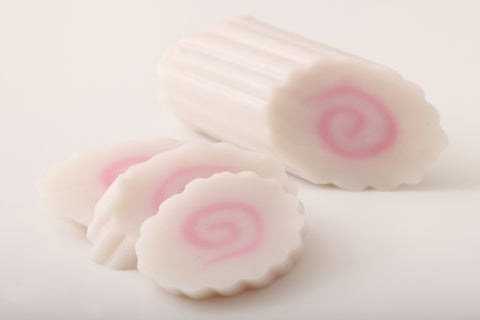
If you are feeling adventurous, you might like to try making Narutomaki yourself. To do so, you will need the following ingredients:
- 7 ounces of non-oily white fish fillets, such as Alaska pollock or southern blue whiting, or 200 grams of pre-made Surimi
- 1 teaspoon salt
- 1 egg white
- 1 teaspoon sugar
- 1 teaspoon Mirin
- Pink food coloring
The following are the steps for making Narutomaki.
- Fill a large pot with several inches of water and bring the water to a simmer. Place a steamer basket on top of the pot.
- If you are making the Surimi yourself, prepare the fish. Remove the skin from the fillets along with any fat and bones. Wash the fish thoroughly under cold running water using a coriander and squeeze any excess water out of the fish. Roughly chop the fish and add it to a food processor bowl. Note: If you are using the pre-made Surimi, just add it to the bowl in this step.
- Add the egg white, salt, sugar, and Mirin and process until a becomes a smooth paste.
- Transfer half of the paste mixture to a small bowl. Mix in the pink food coloring one drop at a time until the mixture is bright pink.
- Place plastic film on a work surface, and using a spatula, spread out the white half (to which coloring is not added) onto the plastic film, in a rectangular shape.
- Spread the pink paste on top of the white paste, with a small border left along the long edges of the white rectangle.
- Roll the fish paste tightly in a fresh piece of film.
- Transfer to the steamer basket and steam for 15 minutes.
How Is Narutomaki Eaten?
As previously noted, Narutomaki is most commonly seen in Shoyu Ramen dishes, where it adds a splash of color to otherwise drably colored ingredients. It is also popularly found in Soba and Udon noodle dishes, as well as being added to clear soups and miso soup.
It can also be added to salads, main entrees, or used as a side dish in its own right. It is also eaten as part of Oden (a winter warmer dish).
Battle Of The Japanese Fishcakes - Are Narutomaki And Kamaboko One And The Same?
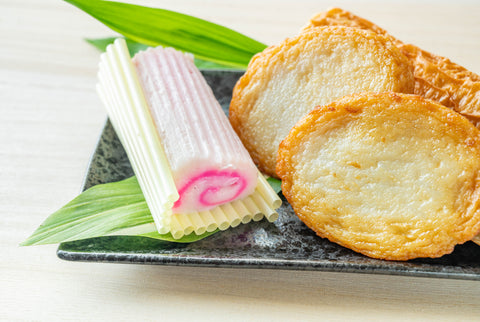
So, is Narutomaki the same thing as Kamaboko?
Well, simply put, all Narutomaki is Kamaboko, but not all Kamaboko is Narutomaki. Kamaboko, another type of Japanese fish cake, comes in many forms, most famously pink or white. The pink variety has a pink ring around a white middle, whereas the white variety is just fully white. Another type of Kamaboko already mentioned is Chikuwa. This is tubular and hollowed out with a grilled exterior and is often used in oden, or fried as tempura. Another type of Kamaboko is Imitation crab sticks, which consist of fish paste seasoned with crab liquid. These are often rolled up in Nori seaweed paper and made into sushi rolls.
Narutomaki is just one type of Kamaboko, specifically the type of Kamaboko with the reddish-pink swirl.
Is Narutomaki Healthy?
Like other forms of Kamaboko, the main ingredient in Narutomaki is minced fish so it is high in protein and calcium. Narutomaki is also extremely low in fat. Although there is a certain amount of added sugar, this is quite low compared to the protein content, and it is generally low in calories.
Depending on the brand, there may be added monosodium-glutamate (MSG) and sodium, but there are also traditional manufacturers who refuse to add these ingredients. So, the bottom line is that if you are concerned about things like MSG and sodium, you should make sure you check the back of the pack before you buy it (or, alternatively, make it yourself and simply refrain from adding these items).
How To Buy And Store Narutomaki?
As discussed earlier in this article, while it is definitely possible to make your own Narutomaki, it does require a significant amount of effort. Unless you are making a large amount of it, it is almost certainly not economical to make your own either, so for the majority of people, purchasing it will be a better option.
Narutomaki can be found in most supermarkets and is a very cost-effective high-protein food source. If sealed in its packet, it can be kept in the refrigerator for up to 90 days. Once you open the packet, it is probably best to consume it within about three days. If frozen, it can be stored for up to 9 months, and you can just cut off the piece you need from the log and defrost that piece each time. As with all meat, however, avoid freezing more than once.
Narutomaki – The Japanese Fish Cake With The Pink Swirl
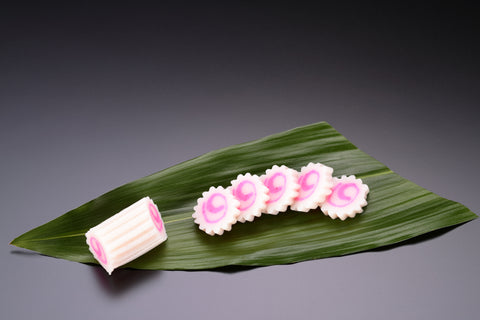
As discussed earlier, due to the changing trends in the popularity of Ramen soups, Narutomaki is being used less recently as a topping for Ramen. However, it is still a popular favorite, alongside other types of Kamaboko, in O-den, clear soups, and a variety of other dishes.
If you like fish and are looking for an economical source of protein and calcium, you should certainly consider including Narutomaki and other types of Kamaboko fish cakes in your diet. In addition to its nutritional benefits, the pink swirl is sure to improve the presentation of your dishes.
Have you tried Narutomaki? Let us know what you think of it in the comments.


0 comments